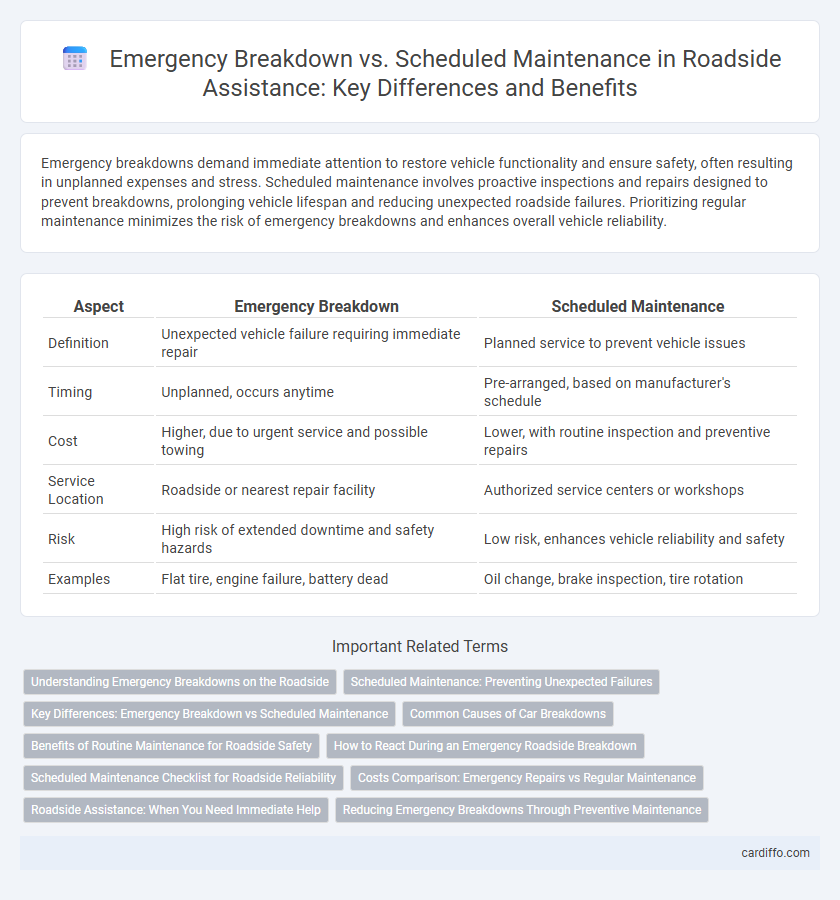Emergency breakdowns demand immediate attention to restore vehicle functionality and ensure safety, often resulting in unplanned expenses and stress. Scheduled maintenance involves proactive inspections and repairs designed to prevent breakdowns, prolonging vehicle lifespan and reducing unexpected roadside failures. Prioritizing regular maintenance minimizes the risk of emergency breakdowns and enhances overall vehicle reliability.
Table of Comparison
| Aspect | Emergency Breakdown | Scheduled Maintenance |
|---|---|---|
| Definition | Unexpected vehicle failure requiring immediate repair | Planned service to prevent vehicle issues |
| Timing | Unplanned, occurs anytime | Pre-arranged, based on manufacturer's schedule |
| Cost | Higher, due to urgent service and possible towing | Lower, with routine inspection and preventive repairs |
| Service Location | Roadside or nearest repair facility | Authorized service centers or workshops |
| Risk | High risk of extended downtime and safety hazards | Low risk, enhances vehicle reliability and safety |
| Examples | Flat tire, engine failure, battery dead | Oil change, brake inspection, tire rotation |
Understanding Emergency Breakdowns on the Roadside
Emergency breakdowns on the roadside require immediate attention due to sudden vehicle failures such as engine stalls, tire blowouts, or electrical issues, which can pose safety risks and cause traffic disruptions. Unlike scheduled maintenance designed to prevent these issues through routine inspections and repairs, emergency breakdowns demand rapid response services like towing or on-the-spot repairs to restore vehicle functionality. Understanding the critical difference helps drivers prepare with knowledge of roadside assistance options and necessary emergency kits for enhanced safety and quick recovery.
Scheduled Maintenance: Preventing Unexpected Failures
Scheduled maintenance plays a crucial role in preventing unexpected roadside breakdowns by systematically inspecting and servicing vehicle components before failures occur. Regular oil changes, brake checks, and tire rotations enhance vehicle reliability and extend lifespan, reducing the risk of emergency repairs. Proactive maintenance minimizes downtime and improves safety, ensuring drivers avoid costly and potentially dangerous roadside emergencies.
Key Differences: Emergency Breakdown vs Scheduled Maintenance
Emergency breakdowns involve unplanned vehicle failures requiring immediate roadside assistance to restore functionality and safety, often caused by mechanical faults or accidents. Scheduled maintenance refers to regular, preventative service checks performed at set intervals to optimize vehicle performance and minimize unexpected breakdown risks. Key differences include timing, with emergency breakdowns occurring unexpectedly, whereas scheduled maintenance is proactive and planned to extend vehicle lifespan and reduce repair costs.
Common Causes of Car Breakdowns
Common causes of car breakdowns include battery failure, flat tires, overheated engines, and fuel system issues, often resulting in emergency roadside assistance. Scheduled maintenance such as oil changes, tire rotations, and brake inspections helps prevent these unexpected failures by addressing wear and tear before they escalate. Ignoring regular maintenance increases the likelihood of sudden breakdowns and costly repairs, emphasizing the importance of proactive vehicle care.
Benefits of Routine Maintenance for Roadside Safety
Routine maintenance enhances roadside safety by preventing emergency breakdowns, which often occur unexpectedly and pose significant hazards to drivers and roadside responders. Scheduled inspections and timely repairs ensure vehicle systems such as brakes, tires, and engine components function optimally, reducing the risk of sudden failures on highways. Consistent upkeep not only improves vehicle reliability but also minimizes traffic disruptions and emergency service interventions.
How to React During an Emergency Roadside Breakdown
During an emergency roadside breakdown, prioritize safety by moving your vehicle to a secure location away from traffic and turning on hazard lights to alert other drivers. Keep emergency contact numbers, such as roadside assistance and insurance providers, readily accessible to ensure prompt help. Avoid attempting major repairs on-site; instead, wait for professional assistance to prevent further damage or injury.
Scheduled Maintenance Checklist for Roadside Reliability
Scheduled maintenance checklist for roadside reliability includes regular inspection of tire pressure, brake systems, fluid levels, and battery health to prevent unexpected vehicle failures. Routine checks of lights, windshield wipers, and engine diagnostics improve safety and ensure continuous operation during roadside travel. Consistent adherence to this maintenance schedule reduces emergency breakdown frequency and enhances overall roadside performance.
Costs Comparison: Emergency Repairs vs Regular Maintenance
Emergency breakdown repairs typically incur higher costs due to urgent towing, expedited parts delivery, and unplanned labor fees, often exceeding those of scheduled maintenance by 50% to 70%. Regular maintenance expenses are more predictable, encompassing routine inspections, fluid changes, and part replacements that prevent major failures and reduce overall repair costs. Investing in scheduled maintenance can lower the total cost of vehicle ownership by minimizing expensive emergency breakdown incidents.
Roadside Assistance: When You Need Immediate Help
Emergency breakdowns demand immediate roadside assistance to ensure safety and minimize vehicle downtime, often requiring rapid towing, battery jump-starts, or tire changes. Scheduled maintenance helps prevent unexpected failures by regularly inspecting and servicing critical components like brakes, fluids, and engine systems. Choosing a roadside assistance provider with 24/7 availability and fast response time is crucial for effective emergency support.
Reducing Emergency Breakdowns Through Preventive Maintenance
Emergency breakdowns often result in costly delays and safety hazards on the roadside, which can be significantly minimized through regular scheduled maintenance. Preventive maintenance involves systematic inspection and servicing of vehicle components such as brakes, tires, and engines, helping to identify potential issues before they escalate into emergencies. Implementing a consistent maintenance schedule improves vehicle reliability and reduces the frequency of emergency roadside assistance calls.
Emergency breakdown vs scheduled maintenance Infographic

 cardiffo.com
cardiffo.com